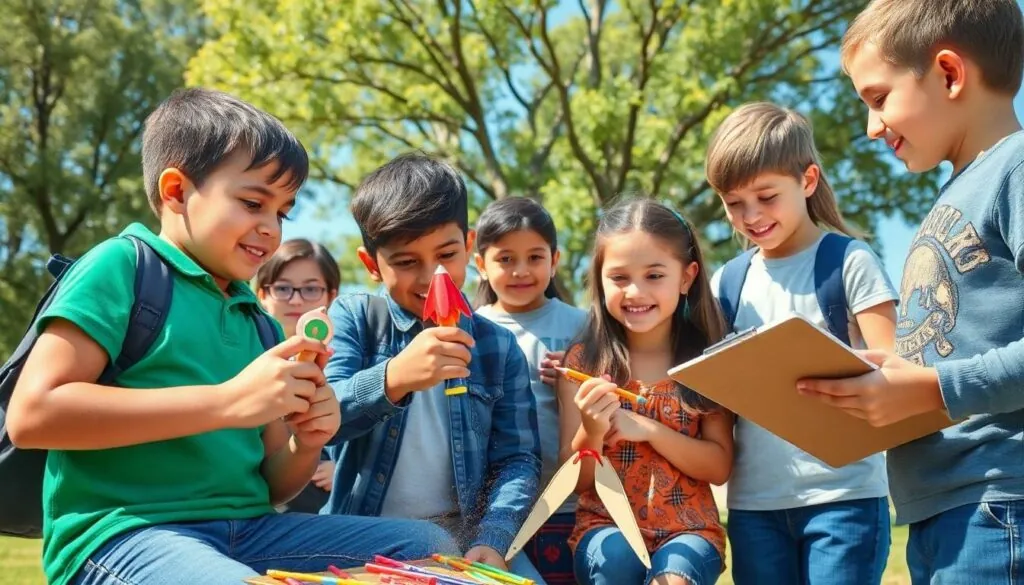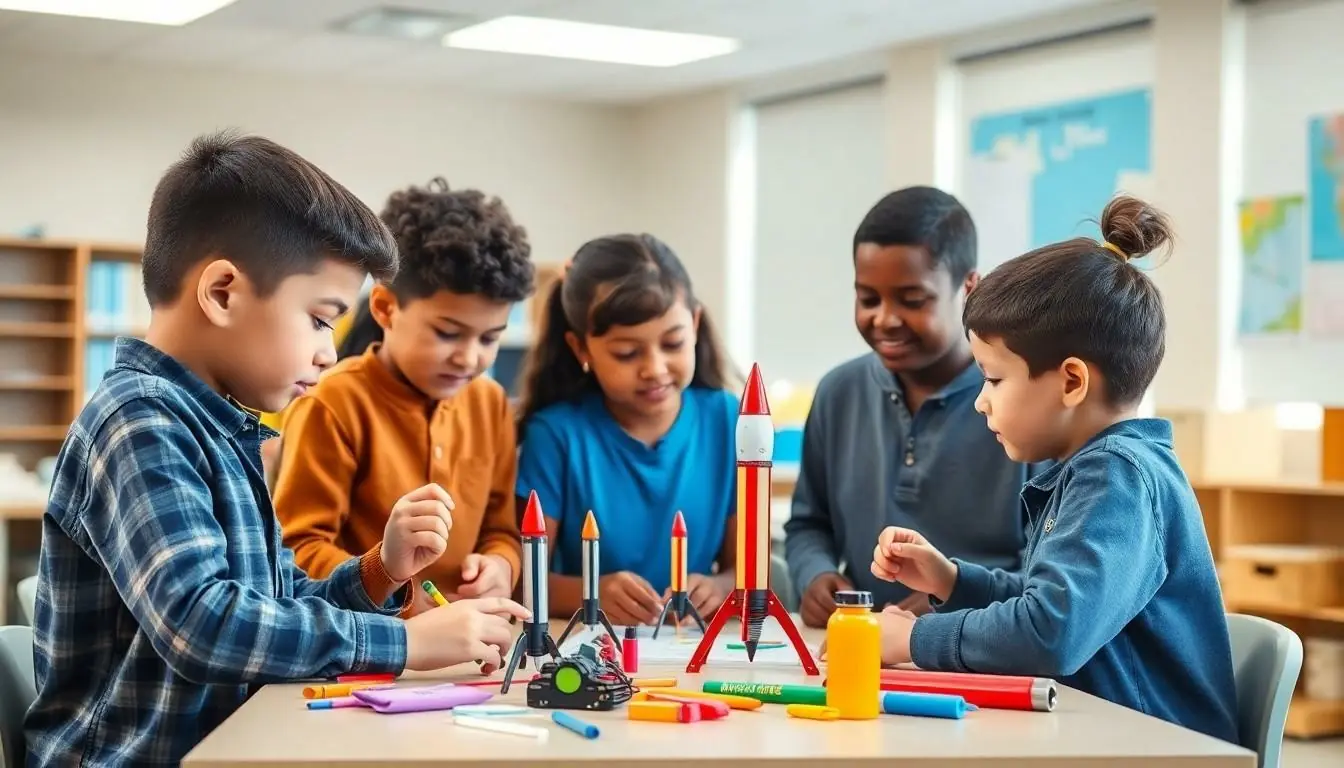Table of Contents
ToggleIn a world where kids are glued to screens, it’s time to spark their curiosity with some hands-on fun. Enter STEAM lessons—where Science, Technology, Engineering, Arts, and Math collide in a glorious explosion of creativity and learning. Imagine your child building a rocket one day and painting a masterpiece the next. Who knew education could be this cool?
Overview of Steam Lessons for Elementary
Engaging children through STEAM lessons fosters creativity and critical thinking. These lessons incorporate Science, Technology, Engineering, Arts, and Math into a cohesive learning experience. One aspect of STEAM education involves hands-on projects that allow students to explore concepts in a tangible way.
Building rockets, for instance, encourages teamwork and problem-solving skills. Creating art projects enhances fine motor skills while introducing basic engineering principles. Students use technology tools, such as coding software, to develop their own interactive stories or games. Each activity correlates with core curriculum standards, ensuring academic relevance.
Collaboration among peers plays a crucial role in STEAM lessons. Group discussions and project-building activities challenge students to express their ideas. Teachers facilitate these sessions, guiding students in their exploration of subjects. This supportive environment nurtures a sense of belonging while boosting confidence.
Assessment in STEAM education differs from traditional methods. Focus shifts from standardized testing to evaluating students’ creativity, collaboration, and problem-solving skills. Teachers might use portfolios or presentations to assess learning outcomes effectively. Encouraging self-reflection allows students to evaluate their growth and understanding of topics.
Incorporating community resources enhances the STEAM experience. Local museums, science centers, and art studios provide additional learning opportunities. These partnerships create a connection between classroom knowledge and real-world application, enriching students’ educational journeys.
Overall, STEAM lessons for elementary students emphasize an engaging, interactive approach to learning. Children thrive in environments where they can experiment, innovate, and collaborate.
Benefits of Steam Education
STEAM education offers significant advantages for elementary students. These benefits extend across cognitive development and social skills enhancement.
Cognitive Development
Cognitive growth occurs through problem-solving activities in STEAM lessons. Children engage with concepts from Science, Technology, Engineering, Arts, and Math with hands-on projects. Experimentation fosters critical thinking, allowing students to analyze and improve their strategies. Building rockets or designing simple machines reinforces logical reasoning and enhances spatial awareness. Innovation thrives in an environment that encourages questioning and exploration. Technology integration, such as coding, promotes computational thinking. Engaging with these skills equips students with tools to succeed academically.
Social Skills Enhancement
Social skills advance through collaboration in STEAM activities. Group projects encourage students to communicate their ideas clearly. Sharing responsibilities fosters teamwork, as children learn to appreciate diverse perspectives. Working together on creative challenges strengthens relationships among peers. Problem-solving as a group builds resilience, teaching students how to overcome obstacles collectively. Discussions during collaborative tasks promote active listening, creating a positive classroom atmosphere. Engaging in STEAM education not only nurtures individual growth but also cultivates a strong sense of community and trust among students.
Key Components of Effective Steam Lessons
Effective STEAM lessons utilize various components to engage students actively in their learning experiences. These components create a comprehensive educational approach that fosters creativity and collaboration.
Integration of Subjects
Integrating subjects is vital in STEAM education. Science concepts pair seamlessly with technology applications, while math skills support engineering design. Arts enrich lessons by providing creative outlets for expression. Students understand complex topics better when multiple disciplines connect. For instance, a project could involve using math to measure materials for a sculpture while applying scientific principles of balance and gravity. Each subject reinforces the others, promoting a deeper understanding. This holistic approach ensures students can see the relevance of their learning in real-world contexts.
Hands-On Activities
Hands-on activities play a crucial role in STEAM lessons. Engaging projects allow students to apply theoretical knowledge through practical experience. Building rockets, programming robots, or crafting art pieces enable exploration of concepts directly. Students encounter challenges that encourage critical thinking and innovation during these activities. For example, constructing a simple machine requires problem-solving skills and teamwork. Participation in hands-on tasks cultivates confidence and self-efficacy, leading to greater enthusiasm for learning. These activities also prepare students for real-world applications, making lessons both enjoyable and meaningful.
Popular Steam Lesson Ideas for Elementary
Engaging students in diverse STEAM lessons can build foundational skills while sparking their interest. Here are some popular ideas for integrating STEAM learning in elementary classrooms.
Science Experiments
Incorporating simple science experiments introduces students to scientific inquiry. Activities like creating volcanoes use baking soda and vinegar, allowing children to observe chemical reactions. Growing plants in different conditions enhances understanding of biology, while mixed-media experiments promote exploration of physics concepts. Students learn to make predictions and analyze results, fostering critical thinking.
Technology Projects
Technology projects engage students through hands-on coding experiences. Platforms like Scratch introduce programming basics as students create interactive stories or games. Robotics kits allow children to build and code robots, encouraging problem-solving and teamwork. Utilizing apps for digital art fosters creativity, aligning technology with artistic expression. These projects make learning relevant and fun.
Engineering Challenges
Engineering challenges stimulate creativity and design thinking. Constructing bridges with everyday materials teaches principles of structural integrity. Building simple machines, such as catapults, helps students understand mechanics through active participation. Challenges often require collaboration, enhancing communication skills and collective problem-solving. These experiences motivate students to innovate and think critically.
Arts and Crafts
Arts and crafts integrate creativity with learning in meaningful ways. Projects like creating 3D models enhance spatial awareness and fine motor skills. Students can explore color theory while painting or engage in textile arts to understand patterns. Music projects introduce rhythm and sound, connecting different aspects of art. Each activity offers a unique outlet for expression.
Mathematics Activities
Mathematics activities blend fun with learning, reinforcing essential skills. Games like scavenger hunts encourage students to apply math concepts in real-world scenarios. Building geometric shapes with blocks enhances spatial reasoning. Incorporating budgeting in classroom projects gives children practical experience with arithmetic. These activities illustrate the relevance of math in daily life and stimulate engagement.
Tips for Implementing Steam Lessons in the Classroom
Creating an inviting classroom environment enhances STEAM lessons. It encourages exploration and experimentation. Display student projects prominently to celebrate creativity. Flexible seating arrangements can promote collaboration among students. Use various learning stations that allow for hands-on activities and foster teamwork. Inviting natural light into the classroom also creates an engaging atmosphere.
Resource management is crucial for successful STEAM lessons. Gather supplies that support a range of activities, such as building materials, art supplies, and technology tools. Establish a resource-sharing system that allows students to access necessary materials easily. Clear storage solutions for supplies can promote organization and independence. Moreover, budget for field trips to local museums or science centers to add real-world context to the learning experience. Emphasizing resource management cultivates creativity while ensuring a structured approach to lessons.
Conclusion
Embracing STEAM lessons in elementary education opens up a world of possibilities for young learners. These hands-on experiences not only make learning enjoyable but also cultivate essential skills like creativity and critical thinking. By integrating various subjects and encouraging collaboration, students develop a deeper understanding of complex concepts while fostering teamwork and problem-solving abilities.
The incorporation of community resources further enriches the learning journey, bridging classroom knowledge with real-world applications. With effective implementation strategies, teachers can create an engaging environment that inspires exploration and innovation. Ultimately, STEAM education empowers students to thrive, equipping them with the tools they need for future success.


